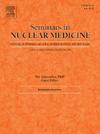Radiotracing the Future: Non-FDG Radiotracers Nuclear Medicine
IF 5.9
2区 医学
Q1 RADIOLOGY, NUCLEAR MEDICINE & MEDICAL IMAGING
引用次数: 0
Abstract
Positron Emission Tomography/Computed Tomography (PET/CT) is an advanced hybrid imaging modality that synergistically combines metabolic and anatomical data, revolutionizing diagnostic accuracy and therapeutic monitoring in various pathologies. While 18F-fluorodeoxyglucose (FDG) remains the cornerstone radiotracer for many oncologic and nononcologic applications, its limitations—such as nonspecific uptake in inflammation and limited sensitivity in certain tumor subtypes—have catalyzed the development and clinical adoption of non-FDG radiotracers. These novel agents exhibit diverse biological targets, enabling more precise characterization of tissue physiology and pathology. Among them, radiotracers such as 68Ga-DOTA Peptides, 18F-fluciclovine, 68Ga-PSMA, 11C-choline, and 18F-FDOPA have demonstrated utility in neuroendocrine tumors, prostate cancer, gliomas, and parkinsonian syndromes. Their application enhances disease detection, improves staging and restaging accuracy, and supports theranostic strategies. The integration of non-FDG PET tracers in clinical practice requires nuanced understanding of their pharmacokinetics, target specificity, and optimal imaging protocols. Furthermore, these tracers open avenues for personalized medicine, allowing for biomarker-guided management. As evidence continues to evolve, non-FDG PET/CT is poised to become indispensable in precision oncology and targeted molecular imaging across multiple disciplines.
放射性示踪的未来:非fdg放射性示踪剂核医学。
正电子发射断层扫描/计算机断层扫描(PET/CT)是一种先进的混合成像模式,它协同结合了代谢和解剖数据,彻底改变了各种病理的诊断准确性和治疗监测。虽然18f -氟脱氧葡萄糖(FDG)仍然是许多肿瘤学和非肿瘤学应用的基础放射性示踪剂,但其局限性-例如炎症的非特异性摄取和某些肿瘤亚型的有限敏感性-催化了非FDG放射性示踪剂的发展和临床应用。这些新型药物表现出不同的生物靶点,能够更精确地表征组织生理学和病理学。其中,放射性示踪剂如68Ga-DOTA Peptides、18F-fluciclovine、68Ga-PSMA、11c -胆碱和18F-FDOPA已被证明在神经内分泌肿瘤、前列腺癌、胶质瘤和帕金森综合征中的应用。它们的应用增强了疾病检测,提高了分期和再分期的准确性,并支持了治疗策略。在临床实践中整合非fdg PET示踪剂需要对其药代动力学、靶特异性和最佳成像方案有细致的了解。此外,这些示踪剂为个性化医疗开辟了道路,允许生物标志物指导的管理。随着证据的不断发展,非fdg PET/CT在多个学科的精确肿瘤学和靶向分子成像中不可或缺。
本文章由计算机程序翻译,如有差异,请以英文原文为准。
求助全文
约1分钟内获得全文
求助全文
来源期刊

Seminars in nuclear medicine
医学-核医学
CiteScore
9.80
自引率
6.10%
发文量
86
审稿时长
14 days
期刊介绍:
Seminars in Nuclear Medicine is the leading review journal in nuclear medicine. Each issue brings you expert reviews and commentary on a single topic as selected by the Editors. The journal contains extensive coverage of the field of nuclear medicine, including PET, SPECT, and other molecular imaging studies, and related imaging studies. Full-color illustrations are used throughout to highlight important findings. Seminars is included in PubMed/Medline, Thomson/ISI, and other major scientific indexes.
 求助内容:
求助内容: 应助结果提醒方式:
应助结果提醒方式:


